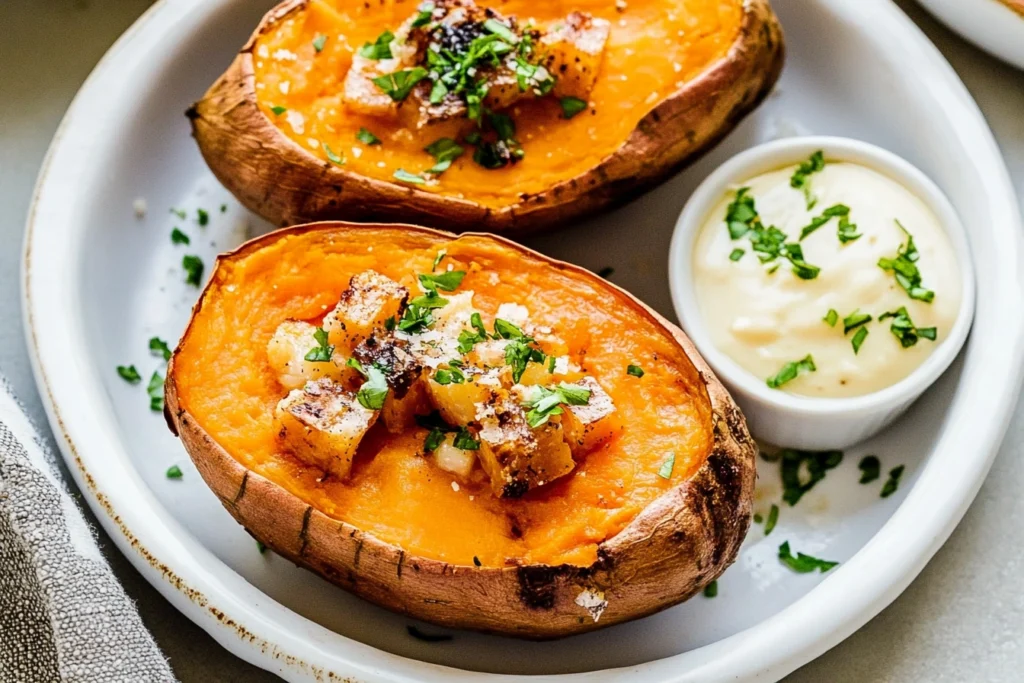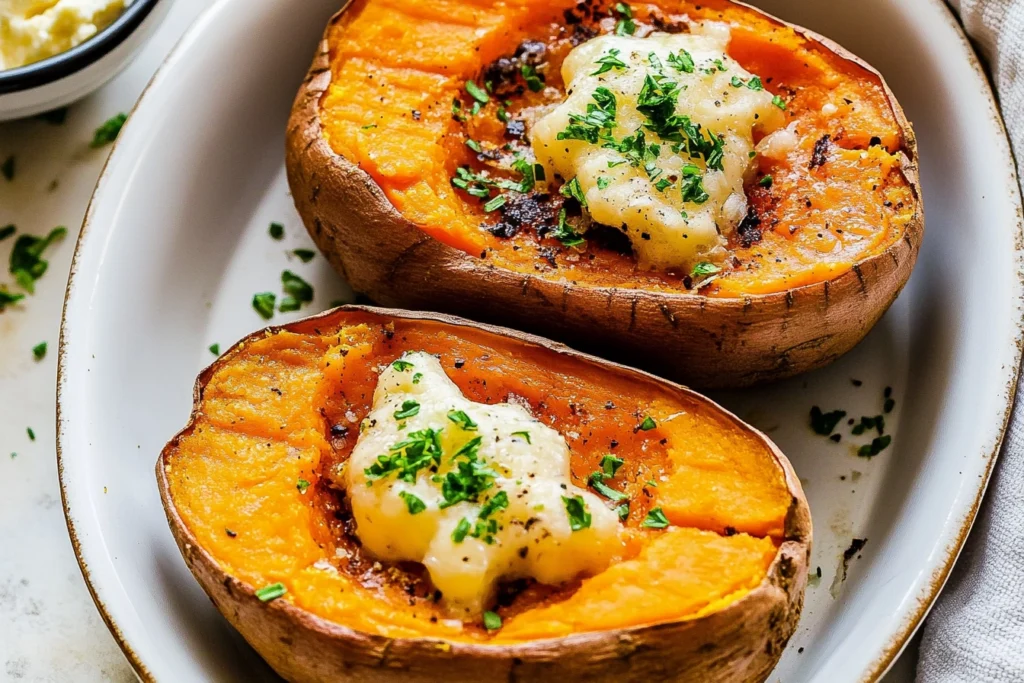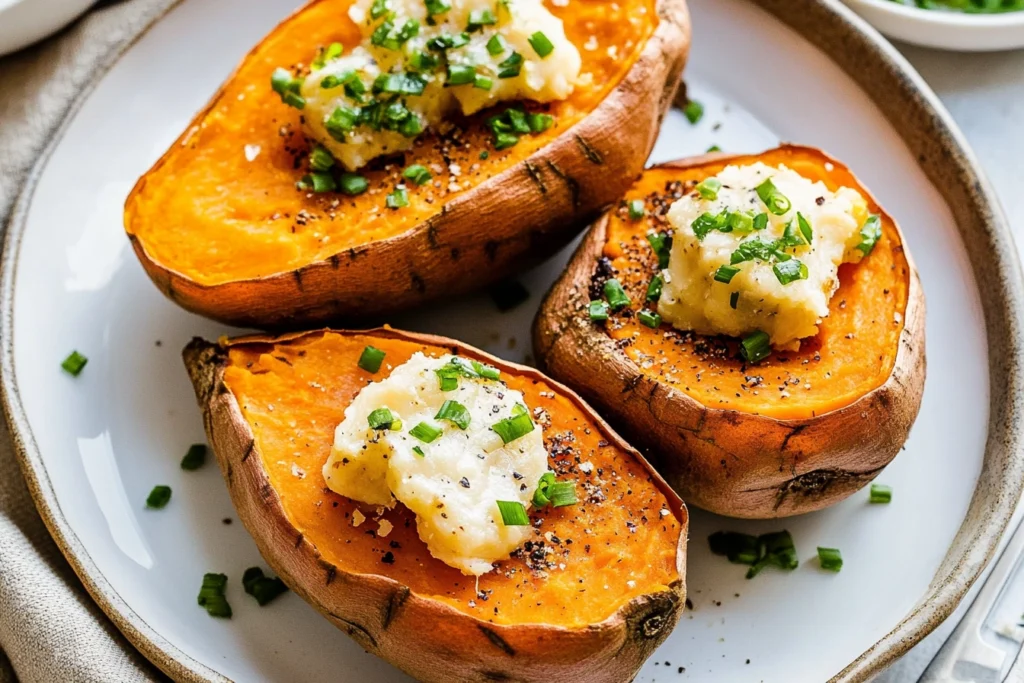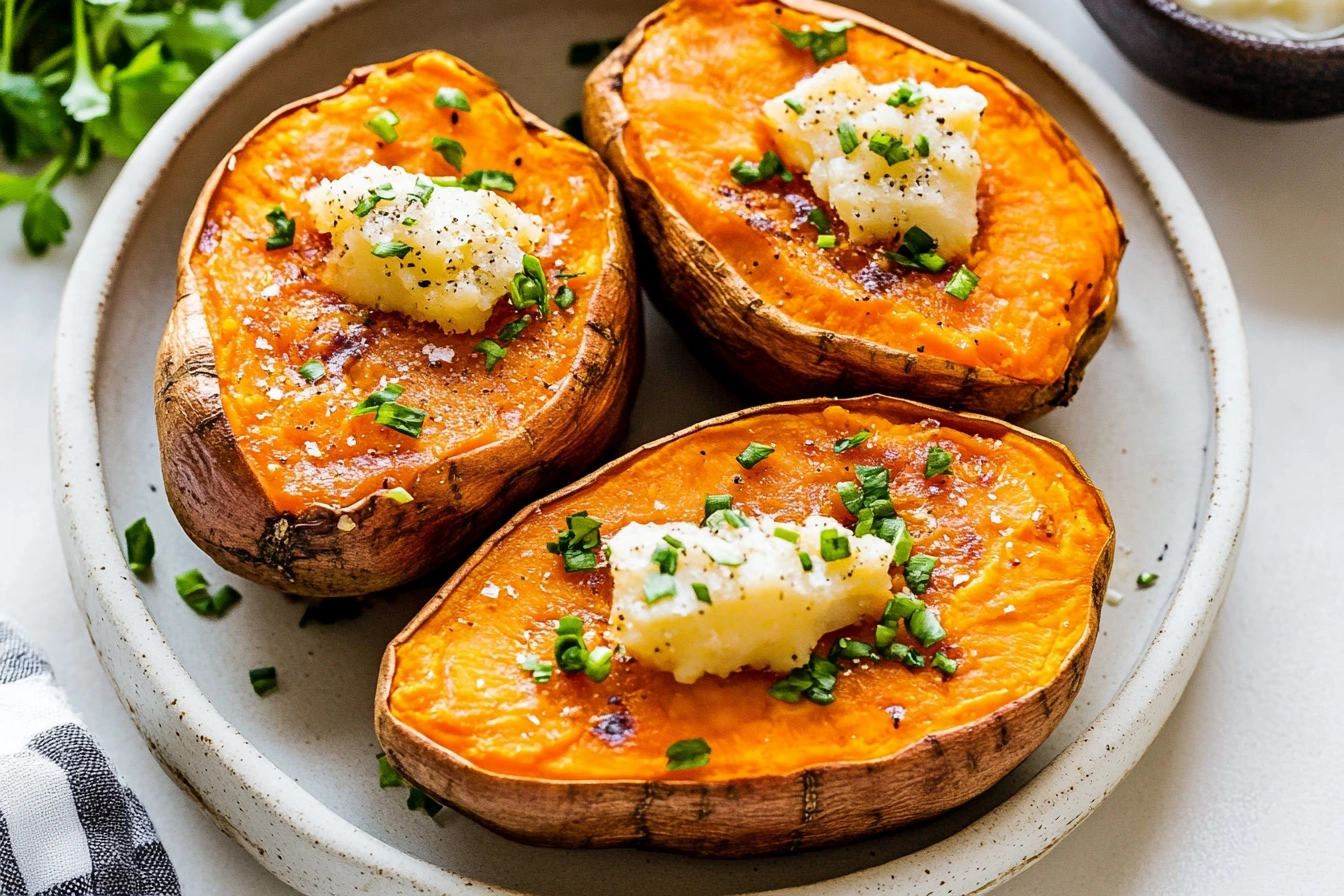Sweet potatoes have become a staple ingredient in kitchens worldwide, thanks to their versatility and nutritional value. This article dives into the world of baked sweet potatoes, uncovering their incredible health benefits, sharing step-by-step instructions for baking them to perfection, and exploring creative ways to serve them. Whether you’re a health enthusiast or just someone looking to spice up your meals, this guide is packed with useful insights.
Introduction to Baked Sweet Potato
What is a Baked Sweet Potato?
A baked sweet potato is a root vegetable cooked in an oven until tender, bringing out its natural sweetness and delightful texture. Known for its vibrant orange flesh (though some varieties are purple or white), it’s a favorite comfort food that pairs well with both savory and sweet toppings. Baking sweet potatoes is one of the easiest ways to prepare them while preserving their nutrients and flavor.
Why Choose Sweet Potatoes Over Regular Potatoes?
Sweet potatoes offer more than just great taste—they’re a nutritional powerhouse. Unlike regular white potatoes, they’re loaded with beta-carotene, a powerful antioxidant that supports eye health and boosts immunity. They also have a lower glycemic index, which means they cause less dramatic spikes in blood sugar levels. So, if you’re seeking a healthier alternative to the standard spud, sweet potatoes are a fantastic choice.

Health Benefits of Baked Sweet Potato
Nutritional Profile of Sweet Potatoes
Sweet potatoes are brimming with essential nutrients. A medium-sized baked sweet potato contains an abundance of vitamin A, which supports eye health, and vitamin C, known for boosting the immune system. It’s also rich in potassium, an important mineral that helps regulate blood pressure. Additionally, sweet potatoes are packed with dietary fiber, making them a fantastic choice for digestive health.
How Baked Sweet Potatoes Support Weight Management
Looking to manage your weight without sacrificing flavor? Baked sweet potatoes are naturally low in calories while being highly satisfying due to their fiber content. Fiber helps you feel full longer, reducing the urge to snack on less healthy options. Pairing them with lean protein or healthy fats can make them a perfect, balanced meal.
The Role of Sweet Potatoes in Digestive Health
The high fiber content in sweet potatoes promotes healthy digestion and prevents constipation. A baked sweet potato contains both soluble and insoluble fiber, ensuring smooth bowel movements and maintaining gut health. This makes them an excellent option for those with sensitive stomachs or digestive concerns.
Immune-Boosting Properties of Sweet Potatoes
Thanks to their rich antioxidant content, sweet potatoes can help strengthen your immune system. Beta-carotene, which the body converts to vitamin A, is particularly effective in supporting skin health and protecting against infections. Vitamin C and other antioxidants found in baked sweet potatoes also combat free radicals, reducing inflammation and supporting overall well-being.
Can Sweet Potatoes Be Part of a Heart-Healthy Diet?
Yes! Sweet potatoes are naturally low in sodium and high in potassium, a combination that promotes healthy blood pressure levels. Their antioxidants also help reduce the risk of heart disease by lowering cholesterol and improving blood vessel function.
Baked Sweet Potatoes as a Superfood
Sweet potatoes have earned their spot on the superfood list. With a combination of essential vitamins, minerals, and fiber, they provide a nutrient-dense option that fits into virtually any diet. Unlike trendy superfoods, sweet potatoes are widely accessible and easy to prepare, making them an everyday staple for many households.
How to Bake Sweet Potatoes Perfectly
Choosing the Right Sweet Potatoes
When baking sweet potatoes, starting with the right variety can make all the difference. Some popular types include:
- Jewel Sweet Potatoes: Known for their moist texture and vibrant orange flesh, ideal for classic baked dishes.
- Garnet Sweet Potatoes: Slightly sweeter with a reddish skin, they caramelize beautifully in the oven.
- Japanese Sweet Potatoes: These have a purple skin and white flesh, offering a nuttier, less sweet flavor.
When shopping, look for firm, smooth sweet potatoes without cracks or soft spots. Avoid overly large ones, as they may bake unevenly.
Preparing Sweet Potatoes for Baking
Proper preparation is key to achieving perfectly baked sweet potatoes. Follow these steps:
- Wash Thoroughly: Rinse and scrub the skin to remove dirt, as the skin is edible and nutritious.
- Dry Completely: Pat them dry with a towel to ensure they bake rather than steam.
- Pierce the Skin: Use a fork to make small holes around the potato to allow steam to escape, preventing bursting.
Step-by-Step Baking Instructions
Follow these simple steps for perfect results:
- Preheat the Oven: Set it to 400°F (200°C) for evenly baked sweet potatoes.
- Wrap or No Wrap: Decide whether to bake them directly on the rack for a crispier skin or wrap them in foil for softer skin.
- Bake Until Tender: Place the sweet potatoes on a baking sheet or directly on the oven rack. Bake for 45-60 minutes, depending on size, until a fork easily pierces the flesh.
Baking Sweet Potatoes Without an Oven
If you don’t have access to an oven, you can use other methods:
- Microwave: Wrap in a damp paper towel and microwave for 5-8 minutes, flipping halfway.
- Air Fryer: Bake at 375°F (190°C) for 30-40 minutes, checking for doneness.
Common Mistakes to Avoid When Baking Sweet Potatoes
- Overcooking or Undercooking: Monitor the texture by testing with a fork to avoid mushy or hard sweet potatoes.
- Skipping the Fork Holes: Without venting, sweet potatoes might burst in the oven.
- Choosing the Wrong Type: Some varieties are better suited for baking than others. Stick to the moist-textured ones for the best outcome.
Creative Ways to Serve Baked Sweet Potato
Classic Toppings for Baked Sweet Potatoes
One of the simplest ways to enjoy a baked sweet potato is by adding toppings that complement its natural sweetness or create a savory balance. Here are a few popular options:
- Sweet Toppings: Add butter, a sprinkle of cinnamon, and a drizzle of honey or maple syrup for a dessert-like treat.
- Savory Options: Top with sour cream, shredded cheese, chopped chives, or even a dollop of Greek yogurt for a creamy, tangy twist.
- Nutty Flavors: Crushed pecans or a spoonful of almond butter adds texture and richness.
Healthy Baked Sweet Potato Recipes
If you’re aiming to keep things nutritious, try these ideas:
- Stuffed Sweet Potatoes: Scoop out the flesh and mix with black beans, corn, and salsa before refilling for a hearty meal.
- Mediterranean Style: Add hummus, cherry tomatoes, and a sprinkle of feta cheese for a light yet satisfying dish.
- Low-Calorie Toppings: Opt for steamed vegetables, herbs, and a squeeze of lemon juice for a refreshing twist.
Baked Sweet Potato as a Side Dish
Sweet potatoes shine as a versatile side dish that pairs well with various main courses. Consider serving them alongside:
- Grilled Proteins: Perfect with chicken, salmon, or lean beef.
- Holiday Favorites: Make them a star in your Thanksgiving or Christmas feast, paired with roasted turkey or ham.
Kid-Friendly Baked Sweet Potato Ideas
For younger palates, transform baked sweet potatoes into something fun and appetizing:
- Sweet Potato Boats: Fill them with melted cheese and their favorite toppings.
- Mashed Sweet Potato Cups: Scoop the flesh into small ramekins and bake with a sprinkle of brown sugar for individual servings.

Variations of Baked Sweet Potato Recipes
Twice-Baked Sweet Potatoes
Twice-baked sweet potatoes are a creative twist that combines the best of baking and mashing. Here’s how to make them:
- Bake the Sweet Potatoes: Follow the basic baking instructions.
- Scoop and Mix: Once cooled, cut them in half, scoop out the flesh, and mix it with butter, cheese, or a dollop of sour cream.
- Refill and Bake Again: Spoon the mixture back into the skins and bake at 375°F (190°C) until golden on top.
Try variations like adding cooked bacon bits, spinach, or shredded chicken for added flavor and texture.
Baked Sweet Potato Fries
If you love crispy snacks, baked sweet potato fries are a healthier alternative to deep-fried options.
- Preparation: Peel and cut the sweet potatoes into evenly sized sticks.
- Seasoning: Toss with olive oil, paprika, garlic powder, and a pinch of salt.
- Baking: Spread them out on a lined baking sheet and bake at 425°F (220°C) for 25-30 minutes, flipping halfway.
For extra crispiness, soak the raw fries in cold water for 30 minutes before baking to remove excess starch.
Mashed Baked Sweet Potatoes
Turn baked sweet potatoes into a creamy, mashed side dish:
- Bake and Scoop: Bake the sweet potatoes, then scoop out the soft flesh.
- Mash: Use a potato masher to blend the flesh with butter, a splash of milk, or even coconut milk for a dairy-free option.
- Season: Add salt, pepper, and optional flavorings like roasted garlic or maple syrup.
This mashed version pairs well with roasted meats and is an excellent option for holiday dinners.
Sweet Potato Breakfast Bowls
Yes, sweet potatoes can even brighten your mornings! Bake one the night before, then reheat and top it with:
- Greek yogurt, granola, and fresh berries for a healthy start.
- Peanut butter, banana slices, and a sprinkle of chia seeds for a protein-packed breakfast.
Sweet Potato Chips
For a light and crispy snack, make baked sweet potato chips:
- Slice sweet potatoes thinly using a mandoline slicer.
- Lay them out on a baking sheet, drizzle with olive oil, and sprinkle with salt or your favorite spices.
- Bake at 375°F (190°C) for 10-15 minutes, flipping halfway.
Storage and Reheating Tips
Storing Leftover Baked Sweet Potatoes
Proper storage can help you enjoy your baked sweet potatoes for days without losing their flavor or texture. Here’s how:
- Refrigeration: Let the sweet potatoes cool completely, then place them in an airtight container. They can be stored in the refrigerator for up to 5 days.
- Freezing: For longer storage, wrap each baked sweet potato tightly in aluminum foil or plastic wrap, then place them in a freezer-safe bag. They can last for up to 6 months in the freezer.
Whether refrigerated or frozen, label the container with the date to ensure you use them before they go bad.
Reheating Without Losing Flavor
Reheating sweet potatoes the right way is essential to maintain their delightful taste and texture. Here are some methods:
- Microwave: Place the sweet potato on a microwave-safe plate, cover it with a damp paper towel, and heat for 2-3 minutes or until warm.
- Oven: Preheat the oven to 350°F (175°C). Place the sweet potatoes on a baking sheet and heat for 15-20 minutes. This method is ideal for preserving their natural caramelization.
- Air Fryer: For a slightly crispy texture, reheat in an air fryer at 375°F (190°C) for 5-7 minutes.
Tips for Repurposing Leftover Sweet Potatoes
- Sweet Potato Patties: Mash the flesh and mix it with breadcrumbs, eggs, and seasonings to create patties. Pan-fry until golden brown.
- Sweet Potato Soup: Blend leftover sweet potatoes with vegetable stock, a splash of cream, and spices for a hearty soup.
- Smoothies: Add cold, baked sweet potato to smoothies for a creamy texture and natural sweetness.

FAQs About Baked Sweet Potatoes
What is the best temperature to bake a sweet potato?
The best temperature to bake a sweet potato is 400°F (200°C). This temperature allows the natural sugars in the sweet potato to caramelize, giving it a sweet, tender interior with perfectly cooked skin. If you’re short on time, you can bake them at 425°F (220°C) for a slightly shorter duration, but keep an eye on them to avoid overcooking.
Is it better to bake sweet potatoes in foil or not?
It depends on your texture preference. Baking sweet potatoes wrapped in foil results in softer skin because the foil traps steam, making it tender and moist. If you prefer crispy skin, skip the foil and bake them directly on a baking sheet or oven rack. Both methods yield delicious results, so it’s entirely up to your taste.
How long does it take for a potato to bake at 400 degrees?
At 400°F (200°C), sweet potatoes generally take 45-60 minutes to bake, depending on their size. Larger sweet potatoes might require closer to an hour, while smaller ones could be ready in 40-45 minutes. To check if they’re done, insert a fork into the thickest part, it should slide in easily.
Do you have to poke holes in sweet potatoes before baking?
Yes, it’s recommended to poke a few holes in the sweet potatoes before baking. This prevents them from bursting in the oven by allowing steam to escape. Use a fork to make small holes around the surface of the potato, but don’t overdo it, just a few pricks are sufficient.
Conclusion
Baking sweet potatoes is not only simple but also a flavorful way to incorporate nutrient-dense food into your meals. From their remarkable health benefits, such as boosting immunity and aiding digestion, to their versatility in recipes and serving styles, baked sweet potatoes are a delight in any kitchen. Whether you enjoy them as a side dish, a meal in itself, or even as a snack, there’s no shortage of ways to make them exciting.
By following the tips and techniques shared in this guide, you can achieve perfectly baked sweet potatoes every time. With their naturally sweet flavor, creamy texture, and endless topping possibilities, they’re a comfort food you can feel good about eating. So, why not try baking some today and discover why this humble vegetable deserves a spot on your plate?
Explore More Delicious Recipes:
- Delicious Smothered Potatoes Recipe: A Southern Comfort Classic
- Irresistible Christmas Crispy Parmesan Potato Stacks Recipe
- Zucchini Recipe: A Complete Guide to Tasty and Healthy Ideas

Baked Sweet Potatoes
- Total Time: 75 minutes
- Yield: 4 servings
- Diet: Vegetarian
Description
A guide to baking sweet potatoes to perfection, highlighting their health benefits and serving options.
Ingredients
- Sweet potatoes
Instructions
- Preheat the oven to 400°F (200°C).
- Wash the sweet potatoes thoroughly and dry them completely.
- Pierce the skin several times with a fork to allow steam to escape.
- Decide whether to wrap in foil for softer skin or place directly on the oven rack for crispier skin.
- Bake for 45-60 minutes until a fork easily pierces the flesh.
Notes
Avoid overly large sweet potatoes as they may bake unevenly. Experiment with various toppings for different flavors.
- Prep Time: 15 minutes
- Cook Time: 60 minutes
- Category: Side Dish
- Method: Baking
- Cuisine: American
Nutrition
- Serving Size: 1 sweet potato
- Calories: 180
- Sugar: 7g
- Sodium: 40mg
- Fat: 0g
- Saturated Fat: 0g
- Unsaturated Fat: 0g
- Trans Fat: 0g
- Carbohydrates: 41g
- Fiber: 6g
- Protein: 4g
- Cholesterol: 0mg


2 thoughts on “Baked Sweet Potato: Easy Guide, Benefits, and Recipes”